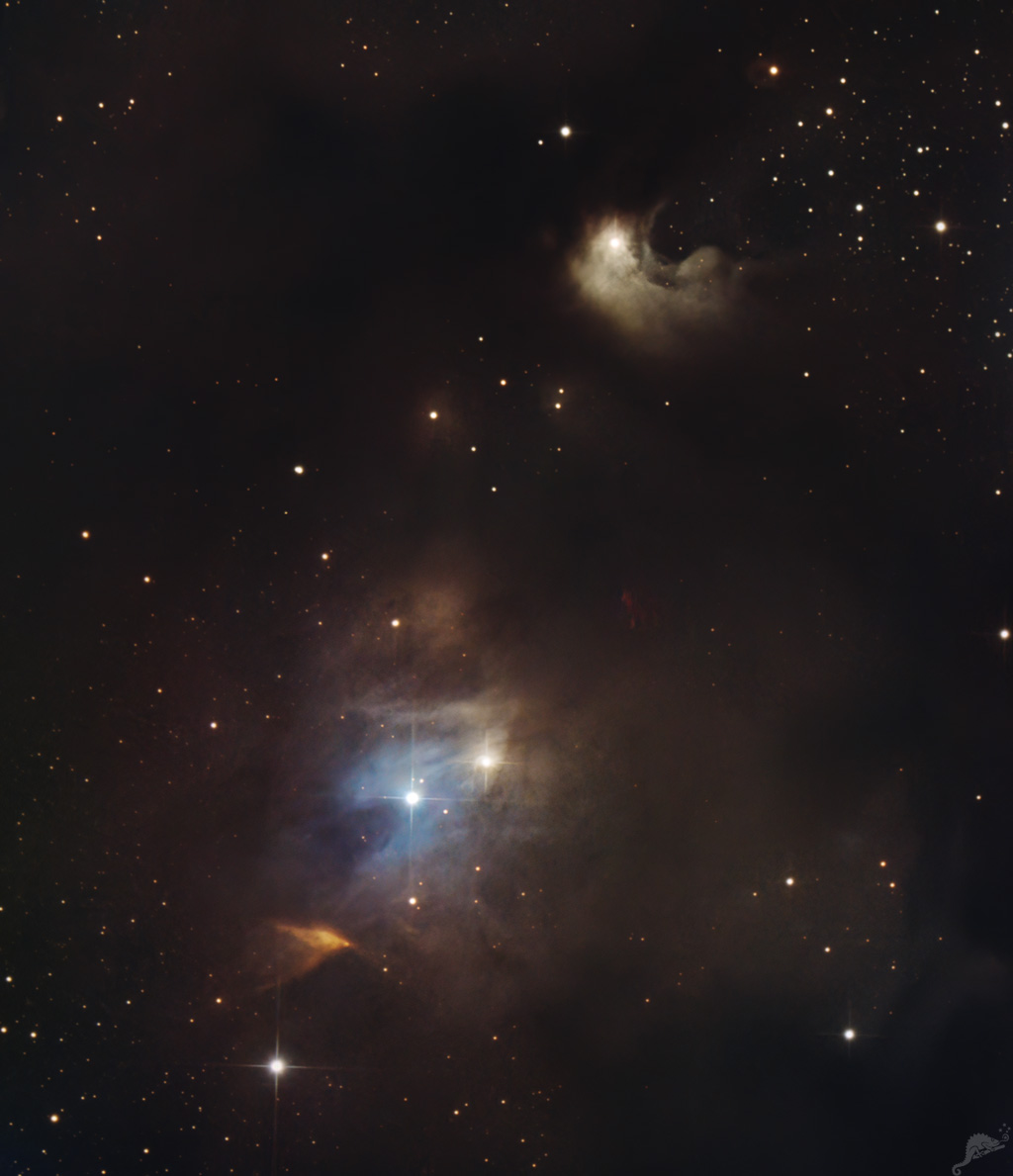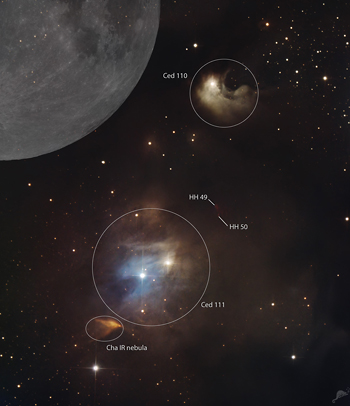 |
CHAMÄLEON + ONJALA OBSERVATORY DeepSky | SITEMAP HOME CHAMÄLEON |
|
 |
|||
| « zurück zur Startseite
galaktische Nebel « back to home galactic nebula |
Großes Bild laden - load large
image 2048 x 1400 Pixel Aufnahmedaten Image data |
Ced 110 and 111 - Reflection nebula in the constellation Chameleon

Das Innere der Chamäleon I Dunkelwolke ist eine aktive Sternentstehungsregion. Einige der neu entstandenen Sterne liegen am uns zugewandten Rand der dichten Molekülwolken und erzeugen eine bunte Mischung an Reflexionsnebeln. Die Region liegt etwa 600 Lichtjahre vom Sonnensystem entfernt und erstreckt sich auf ungefähr 5 Lichtjahre.
Weiterhin zeigt unser 2-er Mosaik zwei Herbig Haro Objekte: HH49 und HH 50. Herbig-Haro-Objekte (nach George Herbig und Guillermo Haro) sind kleine neblige Gebilde um junge Sterne. Sie entstehen, wenn von sehr jungen Sternen ausgestoßenes Gas auf interstellare Staubwolken trifft. Herbig-Haro-Objekte wurden zuerst im späten 19. Jahrhundert von Sherburne Wesley Burnham beobachtet, wurden aber bis in die 1940er Jahre als Emissionsnebel interpretiert. Es sind mit nur ein paar tausend Jahren sehr kurzlebig Objekte und Teil der Sternentstehung.
Eine Weitwinkelansicht der Chamäleon I Dunkelwolke zeigen wir hier.
 |
Object
description The interior of the Chameleon I dark cloud is an active star-forming region. Some of the newly formed stars lie on the edge of the dense molecular clouds facing us, producing a colorful mixture of reflection nebulae. The region is located about 600 light-years from the solar system and extends to about 5 light-years. Furthermore, our mosaic of 2 shows two Herbig Haro objects: HH49 and HH 50. Herbig Haro objects (after George Herbig and Guillermo Haro) are small nebulous formations around young stars. They form when gas ejected from very young stars encounters interstellar dust clouds. Herbig-Haro objects were first observed in the late 19th century by Sherburne Wesley Burnham, but were interpreted as emission nebulae until the 1940s. At only a few thousand years, they are very short-lived objects and part of the star formation process. A widefield view of the Camäleon I molecular cloud is shown here. « Hier oder auf das Vorschaubild zum Laden eines großen Bildes mit Objektbezeichnungen und Größenvergleich zum Mond klicken « Click here or on the thumbnail to load a large image with object annotations. |
Ced 110 and 111 - Reflection nebula in the constellation Chameleon
Image data
27.04.- 06.05.2022 - 2-er mosaic, total 74 x 600 s, Alccd 12 (cooled) + Canon EOS 700 DA (cooled)
Telescope: Planewave CDK 12.5 with Televue 0.8x Reducer at f = 2030 mm
Location: Chamäleon Observatory, Onjala Lodge, Namibia
Image acquisition and processing: Nebulosity, Starnet++, Photoshop
 |
 |
 |
 |
 |
 |
 |
| Sonne | Mond | Sonnensystem | DeepSky | Weitwinkel | Verschiedenes | Spez. Projekte |